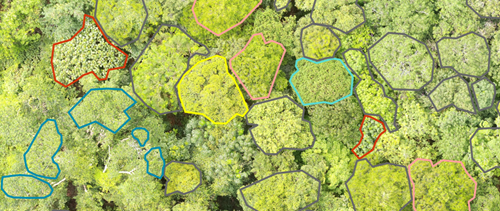Computer-Vision Tree Classification from Drone Multispectral Imagery
This project aims to develop a “companion” as a application that aids ecologists in forecasting the secondary forest recovery process by using metrics derived from aerial drone imagery. This project has quite a few moving components, we’ll discuss them in the following sections.
Roles
I completed these tasks, I’ve categorized them into roles.
ML Engineering:
- Developed an end-to-end PyTorch Lightning model training pipeline for automated tree classification.
- Automated the entire training process using GitHub Actions for improved efficiency and reproducibility.
ML Research:
- Increased classification accuracy from 40% to 65% by combining FixMatch, a state-of-the-art semi-supervised learning framework, with a performant backbone network, EfficientNetB1.
DevOps:
- Implemented Infrastructure as Code (IaC) with Terraform for easy cloud infrastructure provisioning with a single command.
- Implemented a CI/CD pipeline using GitHub Actions promoting robust model performance and production stability.
- Enabled continuous model training with CML and real-time performance monitoring through Weights & Biases (W&B) to detect unintentional model degradation.
MLOps:
- Implement Continuous ML Training with PyTorch Lightning and reporting with W&B.
Management:
- Onboarded team of 6 onto Agile Project Management platform Jira, significantly improving project progress tracking, transparency and individual contributions.
High-Performance Computing:
- Developed an open-sourced high-performance GLCM algorithm on CUDA, 6000x increase in efficiency over standard industry methods. https://github.com/Eve-ning/glcm-cupy
ML Engineering: Foundational Architecture
flowchart TD
A[Annotation Application] -- Feeds Annotations --> B
B[Machine Learning Model] -- Predicts --> A
C[Drone Survey Data Lake] -- Supplies Images --> A
B -- Forecasting --> D[End-User Dashboard]
The high-level architecture is the above, drone images are dropped off in GCP, which is then fetched in the self-hosted annotation web app Label Studio. Then, our server, spins up the PyTorch Lightning machine learning model training and evaluation to output forecasts into the dashboard on Weights & Biases.
To prepare all of these, we used
- Terraform to spin up GCP Compute Engines hosting Label Studio,
which uses an external persistent PostgreSQL database on Supabase.
- For local development, we used Docker Compose to spin up Label Studio and manage our own PostgreSQL
- PyTorch Lightning fetches images from GCP Cloud Storage, and annotations from Label Studio (whether online or offline). Constructs the ML Training procedure, and outputs artifacts to Weights & Biases
flowchart TD
T[fa:fa-code Terraform] -- Spins Up --> GCE[fa:fa-cloud Google Compute Engine]
T -- Spins Up --> SP
GCE -- Survey Images --> LS[fa:fa-check Label Studio]
D[fa:fa-cube Docker] -- Spins Up --> LS
D -- Spins Up --> PG
SP[fa:fa-cloud Supabase] --> PG[fa:fa-database PostgreSQL]
PG <-- Annotations --> LS
GCE -- Survey Images --> PYL[fa:fa-brain PyTorch Lightning]
LS -- Annotations --> PYL
PYL -- Predictions --> LS
PYL -- Report --> WAB[fa:fa-chart-bar Weights and Biases]
The above shows the entire system we architected to realize this solution.
ML Research: Transforming Images to Numbers
We achieve this complex transformation of imagery to metric using a performant CNN backbone (EfficientNetB1) and further improve its performance through Semi-Supervised Learning (FixMatch).
We can think of the backbone, EfficientNetB1, as a function that transforms an image into numbers. To give some intuition, we show some pseudocode below on how it works analogously.
from models import EfficientNetB1
features_cat = EfficientNetB1.transform("cat.jpg")
print(features_cat["feature_a"])
# 1.434
features_jeff = EfficientNetB1.transform("jeff.jpg")
print(features["feature_a"])
# -0.934
Keep in mind that the features is not a set of well-defined english keys,
instead some abstract representation of the image. These features are optimized
such that they are important in distinguishing cat.jpg from other images like
frog.jpg or jeff.jpg.
Next, FRDC suffers from the fact that we have too little labelled data in comparison to unlabelled. If we had gone forth with classical supervised ML approaches, we’d be neglecting a large portion of our data. Fortunately, despite without labels, unlabelled data can help contribute in improving model generalization performance!
This approach is known as Semi-Supervised Learning (SSL). While it is applicable to most situations, its additional effort may not be significant if the labelled data is already generalizing well.
I won’t go into detail about the ML side, but take a look at FRML: Semi-Supervised & Active Learning Applied Machine Learning for Aerial Tree Classification for more details on how it works.
